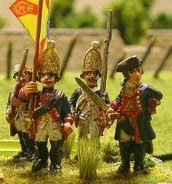Sorry for the lack or posts lately. Between the holidays, work and some other hobbies I've been spending time on, I haven't had as much time for wargaming as I'd like to have. This is the next installment for my early WWII German Pioneer company. It is a chemical mortar platoon, aka Nebelwerfer platoon. I always thought Nebelwerfers only referred to the six-barrel rocket launchers, but to my surprise the word actually translates to 'Smoke Projector'. This model of mortar was also called a Nebelwerfer by the Germans.
This platoon should give my pioneers an inexpensive source of smoke, and some mass crowd control for Polish and British infantry hordes. For our escalation league, they'll be an affordable option to use for now while my pioneers are fielded as non-mechanized pioneers. Later on when I get my armor attachments and I convert to mechanized pioneers, these are not available on the TO&E. Still I'm happy to have them now and they were relatively quick to paint.
Today, on New Years Eve day, we got together for an impromptu make-up day for our escalation league since the scheduled day for our last game was December 25th. Jerry and I played a 1000-point game using the Cauldron scenario. Being infantry versus Jerry's French Armor, I was defending the center of the board.
Jerry missed his first reinforcements, which allowed me to focus my heavy artillery on one of his platoons, knocking it out. On turn two Jerry received two platoons of reinforcements, and from that point on he was able to pressure my static position easily, first knocking out my only AT asset my heavy guns, then my Infantry. I missed getting my reinforcements until turn five, which was pretty much too late to get them into the game, particularly since I failed all three of my stormtrooper rolls with my PaK-36 AT guns.
Jerry played a good clean game, making no mistakes for me to work with, and defeated me easily. In hindsight I probably should have deployed my PaK-36 guns at the beginning of the game and brought my heavy guns in from reserve since they would probably have done better at long range and the higher rate of fire of the PaKs would have been welcome early. Lesson learned. I'm not sure that one change would have swung the game for me, but it might have helped.
I'm still feeling that at 600-1000 points the light/medium armor forces, particularly in early war, have a large advantage. In five assaults Jerry was able to kill 7 of my infantry stands while I scored zero tank kills even though I passed all of my tank terror rolls. I know some people play infantry forces with great success against armor, but in early war with TA-3 engineers, and no panzerfausts, bazookas, etc. I think it's a very lopsided fight. Reducing engineers from tank assault 4 to tank assault 3 in early war really stings.
Photos from our game are below.

















